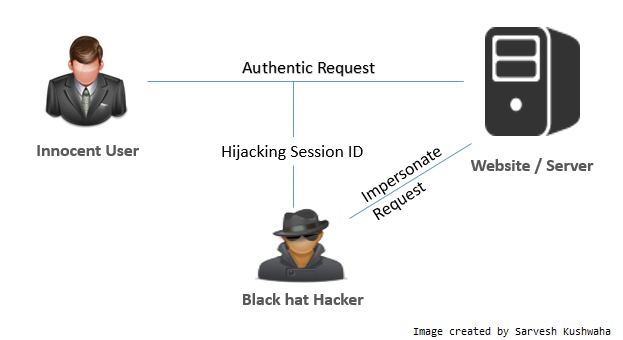Introduction
This article is the Part-5 of my series Hack Proof your asp.net and asp.net mvc applications. In this article, I will describe what exactly Session Hijacking (Man-in the-middle-attack) is and how a hacker exploits it and how we can prevent Session Hijacking attack in asp.net applications.
DownloadSessionHijackingPrevention.zip
Background
You can read previous article of this series from below links :
- Secure your ASP.NET applications from SQL Injection
- Secure your ASP.NET applications from XSS Attack
- Secure your ASP.NET applications from CSRF Attack
- Secure your ASP.NET applications from Sensitive Data Exposure and Information Leakage
Session Hijacking
Before explaining session hijacking i want to tell how asp.net do session management.Whenever a new session is created a cookie is generated for that user , this cookie becomes the session ID , so all the request can serve using that session ID.
If somehow a hacker can sniff or steal the session id he can forge the request as a valid user (i.e impersonate as you) .

Impact of session hijacking is Severe , attacker can do anything what a Authentic user allowed to do on any website.
How is it Exploited :
Below are some ways , How to Session ID can be attacked :
- Sniffing of session on less secure network,
- Man in the middle attack (Any proxy configuration installed on system example : See your traffic easily on fiddler),
- Stealing from Victim machine,
- alert cookie using XSS attack,
- if url based session is used ,Simply copy and paste session ID from url.
DEMO FOR ASP.NET APPLICATION :
To Demonstrate Session Hijacking I am using two different browsers (Chrome and Mozilla)
different programs with different session.Note : Normally this attack occurs on different machines.
User logged into chrome and generated the Session ID : (Chrome in my case) 
Attacker sniffed your session ID : (Mozilla)
Attacker now logging into another machine and used your session ID :

Result :

and you know the consequences of the Session Hijacking.
How to prevent Session Hijacking :
Following are the ways of Preventing session Hijacking in asp.net applications :
1. The idea basically Generate the hashkey which contains the Browser Detail , Browser Version, Browser platform, User Identity, IP address (Additionally/Optional).
And validate this hash key for every Get and POST request.
For that you can use Global.asax Application_BeginRequest and Application_EndRequest , Or Application_AcquireRequestState .
In My Demo i am using the Begin and End request methods of global.asax.
In Application_BeginRequest :
Step1: Check if its a new session or not , if not then do the further checks
Step2: Retrieve the value of ASP.NET_SessionID
Step3: Generate the Hash Key for this POST/GET request and match with Previous ASP.NET_SessionID
Step4: If Valid request the remove the Overhead you have added in ASP.NET_SessionID like (IP address , BrowserVersion , Browser Platform ) so application can work smoothly.
protected void Application_BeginRequest(object sender, EventArgs e)
{
if (Request.Cookies["ASP.NET_SessionId"] != null && Request.Cookies["ASP.NET_SessionId"].Value != null)
{
string newSessionID = Request.Cookies["ASP.NET_SessionID"].Value;
if (newSessionID.Length <= 24)
{
Response.Cookies["TriedTohack"].Value = "True";
throw new HttpException("Invalid Request");
}
if (GenerateHashKey() != newSessionID.Substring(24))
{
Response.Cookies["TriedTohack"].Value = "True";
throw new HttpException("Invalid Request");
}
Request.Cookies["ASP.NET_SessionId"].Value = Request.Cookies["ASP.NET_SessionId"].Value.Substring(0, 24);
}
}
In Application_EndRequest :
Just Add again the hash-key and pass to the browser.
protected void Application_EndRequest(object sender, EventArgs e)
{
if (Response.Cookies["ASP.NET_SessionId"] != null)
{
Response.Cookies["ASP.NET_SessionId"].Value = Request.Cookies["ASP.NET_SessionId"].Value + GenerateHashKey();
}
}
To Generate Hash-key add this function in your global.asax :
private string GenerateHashKey()
{
StringBuilder myStr = new StringBuilder();
myStr.Append(Request.Browser.Browser);
myStr.Append(Request.Browser.Platform);
myStr.Append(Request.Browser.MajorVersion);
myStr.Append(Request.Browser.MinorVersion);
SHA1 sha = new SHA1CryptoServiceProvider();
byte[] hashdata = sha.ComputeHash(Encoding.UTF8.GetBytes(myStr.ToString()));
return Convert.ToBase64String(hashdata);
}
2. Another way of preventing the Session Hijacking force SSL to the entire website and make sure cookies are flagged as secure.
3. Remove your Session Id and Expire the session at the time of log out.
Example : In log out page add this to load of that page
Session.Abandon();
Response.Cookies["ASP.NET_SessionId"].Expires = DateTime.Now.AddDays(-30);
Thanks for reading this article.Alternatively you can donload the whole code from my git repository :
https://github.com/sarveshkushwaha/SessionHijackingPreventionAspNet
References and Further Readings:
http://stackoverflow.com/questions/22880/what-is-the-best-way-to-prevent-session-hijacking
http://dotnet.dzone.com/articles/aspnet-session-hijacking
